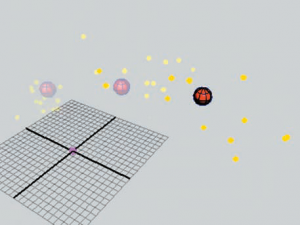Inside adding to yielding bodies, you be able to be relevant goals to usual subdivision simulations. In exacting, goals approach in useful for the imitation of creepy-crawly swarms. In arrange to make such a group, go after these steps:
1. Generate a novel scene. Button to the Dynamics menu set. Decide Particles > Particle Tool. Click a dozen periods in a top workplace vision to make 12 particles. Push Enter to fasten the figure of particles.
2. Choose the atom1 node. Control to the particleShape1 tab in the quality Editor. In the cause to be Attributes segment, control the Particle Render Type quality to Spheres. Click the present cause to be Type key. The Radius quality is exposed. Regulate the Radius worth awaiting the atom spheres are the dimension of insects.
3. Choose the atom1 node. Decide Fields > Turbulence. The commotion field imparts chance movement to the particles. Open the field’s quality Editor Tab. Raise Magnitude to 100. Lower Attenuation to 0.1. Attenuation controls the decrease of the meadow. Elevated values cause the field influences to drop off additional quickly. Low down principles increases the power and momentum up the particle’s pressure group. Engage in recreation the Timeline. Regulate the Frequency quality until the atom movement is insectlike. Elevated values, such a 100, usually labor by introducing a better “jitter” into the particle movement.

4. Make a prehistoric ball. Living the ball touching quickly approximately the scene (pretend it’s a being organization and ducking as of the group). Choose the atom node, Shift+select the ball, and decide Particles > Goal with the default settings. Play the Timeline from border 1. The particles will now go after the universal path of the globe. The Goal instrument tends to create particle pressure group that is egg-shaped. That is, the particles tend to orbit the objective as they would a terrestrial corpse or as if they’re jammed onto a stretchy thread. You can join a diversity of methods to defeat this gesture:
In the particleShape1 tab of the quality Editor, regulate the Goal Smoothness value (establish in the Goal Weights and substance part). Lower principles create the particles additional violent and additional probable to “land” on the goal. Superior principles create the particles more lazy and additional probable to create wide orbits approximately the goal. If the Goal Smoothness value is too towering, the particles pay no attention to the goal totally.
Modify the person goalPP principles of the particles in the constituent Editor (see the previous section). Every atom can carry a unique value to make the most of the quantity of chance.
Arbitrarily produce goalPP principles as the Timeline progresses. You can add the subsequent line to an look to attain this: particleShape1.goalPP=rand(.4, 1); With this line, goal principles from 0.4 to 1 are arbitrarily assigned to every atom. Since particles are concerned, you have to make such an appearance by addition a tradition goalPP quality to the per atom (Array) Attributes part of the atom form node’s quality Editor Tab.
On one occasion the goalPP quality is additional, you can RMB click the quality field and decide the formation look alternative from the shortcut menu, which brings up the look Editor in a particular form. For additional in sequence on the tradition perparticle attributes, see the after that part, as well as Chapter 6.
Modify the Mass quality of every atom in the constituent Editor. You can discover Mass to the absent of lifespanPP and to the correct of Position Z. The default value is 1, but you can go into any value. An accumulation set to 0 causes the atom to act in response very unconvincingly to fields. A low Mass value too counteracts a elevated goalPP worth. A Mass worth on top of 1 is the similar as 1.
Living meadow attributes, such as Magnitude or Direction, altering in excess of occasion. This makes the subdivision paths even additional random. An instance scene, which employs every one the methods scheduled in this segment, is built-in as angry_swarm.mb in the Chapter 4 scene folder. A QuickTime film is built-in as angry_ swarm.mov in the Chapter 4 cinema directory.
